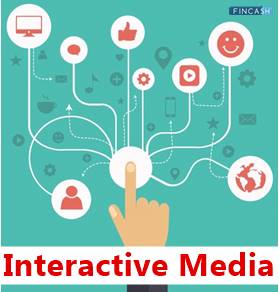
Table of Contents
What is Interactive Media?
Interactive media refers to any kind of media that accepts the user input and responds accordingly. It can be print, digital, or a combination of both. To put it simply, it is a method of communication through which people process and share various information.

Social media, virtual reality, and apps are some of the common types of interactive media that can be used to enhance user experience. They allow the users to engage and interact with people or organizations through texts, graphics, and sounds.
Types of Interactive Media
Interactive media emerged through the Internet revolution of the 1990s, thriving through advanced technology like smartphones and laptops.
Here are some common types of interactive media:
1. Virtual Reality
Virtual Reality creates a simulated immersive environment using computer technology. With this, the users can experience a world that's a digital twin of physical reality.
Talk to our investment specialist
2. Social Media
Social networking websites like Facebook, Instagram, or Twitter are yet another example of interactive media. Using graphics and texts, they allow users to share photos or information, chat and play games.
3. Apps
Apps are application software for mobile devices such as weather apps to help you know about the weather or maps to guide you to the desired location.
4. Games
Electronic games include the use of advanced computer programming and animation techniques to create moving images and graphics on a screen. Here players use controllers to respond to the sound cues and illustrations.
Importance of Interactive Media
Interactive media plays a crucial role in today's technologically advanced era. It has not only made people more active but also changed the way they traditionally approached different personal and professional aspects of life.
Here are some advantages of interactive media:
Effects on Learning and Education
Interactive media has made a great impact on the educational sector. It helps students with different styles of learning, including visual, verbal, auditory, and tactile styles. Using educational computer software can help students enhance their communication skills and become more active in learning and acquiring new skills.
Relationships
Interactive media promotes the dialogic form of communication, enabling the senders and receivers to build a strong, long-term relationship. Many organizations use interactive media in an attempt to go beyond basic marketing and develop positive behavioural relationships.
Intuitive
Another advantage of various forms of interactive media is that they make technology more intuitive to use. For instance, interactive products like iPads, iPods, and smartphones are created with intuitive use in mind, making up for a user-friendly interface. This often encourages the users to experiment with their product rather than reading the detailed instruction manual to operate it.
Takeaway
Interactive media is nowhere restricted to the field of information technology (IT); instead, it incorporates any technology that provides feedback based on the user's action. Today, it is widely being implemented across a variety of platforms and applications to enhance user experience. Plus, with the advent of more powerful machines, interactive media is likely to become more immersive, broadening the scope of possibilities for future generations.
All efforts have been made to ensure the information provided here is accurate. However, no guarantees are made regarding correctness of data. Please verify with scheme information document before making any investment.





